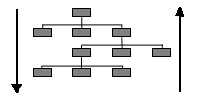Sequence Diagram
Conceptual Diagram
Use Case
Activity Diagram
| SuperBell Inc. sells communication services.
To place an order, customers can call a customer service representative (CSR),
who will fill the order (paper) form.
Orders will be entered into the system by an order entry clerk (OE Clerk).
UML: Case Study.
Example of using UML by Yelena Gelfand. Instructor Jeff Zhuk
|
The SuperBell company uses a Person object from which it inherits general information
such as name and ID. From this, both Customers and Employees (CSR and OE Clerk) are inherited.
|
|
|
|
- attributes
- ID
- firstName
- lastName
- initial
- methods
- giveName
- add
- remove
|
|
|
|
|
Person |
|
|

|
|

|
|
|
Customer
|
|
Employee
|
- attributes
- ID
- firstName
- lastName
- initial
- *salutation
- methods
- giveName
- add
- remove
|
|
|

|
|

|
- attributes
- ID
- firstName
- lastName
- initial
- *SSN
- methods
- giveName
- add
- remove
|
|
|
|
|
OE Clerk
|
|
CS Rep.
|
Figure 2-4 Specialized Classes Inherited From Employee
Inheritance Definition
Inheritance is often represented as a tree. Moving down the tree,
classes become more specialized, more honed toward an application.
Moving up the tree, classes are more general; the contain members
suitable for many classes but are often not complete.
| Specialization
|

|
Generalization
|
Figure 2-3 Specialized and Generalization
Objects rarely fall into completely distinct groups;there is often
considerable overlap in the operations of object groups.
Changing Inherited Members
You might not always want a specialized subclass to inherit all
the members of the superclass, or to inherit the members exactly as they
are. To customize the members for a subclass, you can override
superclass members. Overriding keeps the member but chenges the
implementation.
You might need to override a method if the superclass provides a
default implementation that is not optimal. Specific subclasses
may override it to provide optimal implementations in light of the
specific context in which they are used. For example,better algorithms
or caching and storage techniques may be possible in specific derived
classes.








